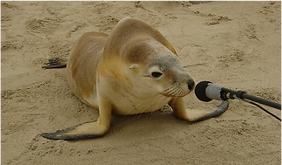Professors, Assistant Professors and PhD students from the ENES lab are strongly involved in teaching at the Université Jean Monnet - Saint-Etienne. Our teachings include:
- Animal cognition
- Behavioural ecology
- Animal communication
- Ethology
- Physiology
- Ecology
- Information theory
- Statistics

International Master of Bioacoustics (MoBi)

© Isabelle Charrier

© Isabelle Charrier
Week 3: Comparative Bioacoustics II- Marine Mammals (3 ECTS)
Organisers and tutors: Isabelle Charrier & Charlotte Curé
Tutors: Olivier Adam, Flore Samaran
Confirmed Guest tutors: Colleen Reichmuth (USA), Filipa Samarra (Iceland), Maevatiana Ratsimbazafindranahaka (Germany), Chloé Huetz (France), Maëlle Torterotot (France), Marjolaine Caillat (France), Fleur Visser (The Netherlands), Héloïse Frouin-Mouy (USA)
Aims: In this module, we will review the production/perception, nature, function of acoustic signals in marine mammals (pinnipeds and cetaceans) as well as the impact of noise. We will describe the different types of acoustic signals produced by pinnipeds, odontocetes and Mysticetes, and the anatomical basis of their production. We will see their hearing abilities, and review the impact of noise on their general behaviour and vocal production. We will also present technologies used to study marine mammal vocal behaviour, from passive to active monitoring and the analysis methods linked to these monitoring methods (PAM and tags). During the practical sessions, we will use sound analysis software such as Seewave, Avisoft and Raven…
Research talks on pinniped and cetacean acoustic communication networks and noise impact will expose you directly to current research.
Learning outcomes
By the end of the module, a successful student should be able to:
-
Demonstrate an understanding of how acoustic signals of marine mammals are produced, structured and perceived;
-
Demonstrate an understanding of noise impact on marine mammals
-
Demonstrate a good understanding of tools for analysing marine mammal vocalisations
-
Demonstrate a good understanding of scientific devices that can be used to study marine mammal behaviour (PAM and tags)
Assessment
The final mark will be based on the oral presentation of a scientific paper (duration = 10 min + 5 min questions).
Schedule
Day 1 – 06 October:
09:00-12:30 Lecture (3h CM): Welcome & Description of marine mammal vocalisations and assessing the biological function of their vocalisations using playback experiments. Case study focused on Pinnipeds. Isabelle Charrier
14:30-17:30 Practical (3h CM/TD): Analysis of marine mammal vocalisations. Use of Pamguard. Marjolaine Caillat (I. Charrier in assistance)
Assignment of scientific papers that will be presented on Friday (1/student).
Day 2 – 07 October
09:00-12:00 Lecture (3h CM): Vocal production in cetaceans, and comparison of vocal apparatus between odontocetes and Mysticetes. Hearing in cetaceans. Olivier Adam
13:00-14:30 Lecture (CM): Using Passive and Active Acoustics for Seal Research. Héloïse Frouin-Mouy (Online).
17:30- 19:00 Lecture (CM): Hearing in pinnipeds. Conference by Colleen Reichmuth (Online).
Day 3 - 08 October
09:00-12:00 Lecture (3h CM): Presentation of the standard and new technologies used to study marine mammals (behaviour and vocal production). Impact of noise on marine mammals. Study case on cetacean species. Charlotte Curé
14:00-17:00 Practical (3h TD): Analysis of multi-sensor tag data. Maevatiana Ratsimbazafindranahaka + Chloé Huetz
Day 4– 09 October
09:00-12:00 Lecture (3h CM): Presentation of passive acoustic monitoring methods for cetaceans. Flore Samaran
14:00-17:00 Afternoon Practical (3h TD): analysis methods in passive acoustic monitoring. Flore Samaran + Maelle Torterotot
Day 5 – 10 October
09:00-10:00: Plenary talk (45min + questions) by Fleur Visser (Online)
10:15-11:15 : Plenary talk (45min + questions) by Filipa Samarra (Online)
12:30-15:30: Oral presentations of scientific papers, 15 min per presentations (10 min Talk + 5 min questions, 2 students/paper) (Isabelle Charrier & Charlotte Curé).

© Isabelle Charrier


© Charlotte Curé (3S project-baseline cruise)





